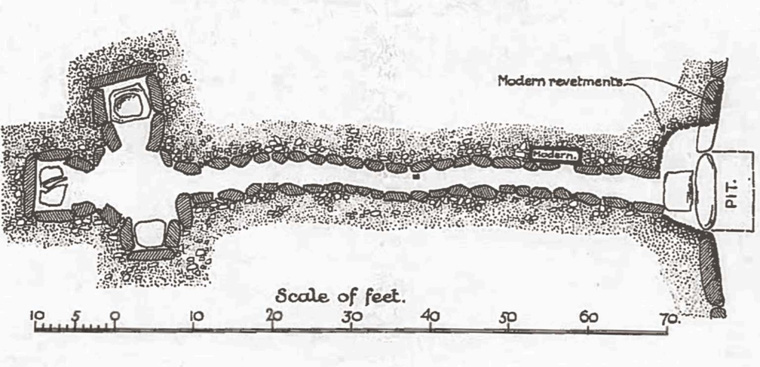Some five miles above the town of Drogheda, the River Boyne sweeps round a tongue of land, about three miles in length and a mile in breadth. This area was chosen, early in the course of the Bronze Age, as the site of an important cemetery. (The Bronze Age is the name given to the stage of civilisation in which the use and properties of iron were yet unknown, and all the most important implements and weapons were made of bronze. In Ireland this period lies approximately between 2000 B.C. and 250 B.C.)
There are a number of burial mounds, standing stones, and earthen enclosures remaining on the site, testifying to its importance in ancient times. The cemetery is not infrequently referred to in ancient Irish literature under the name, Brugh na Bóinne, "Palace of the Boyne." Its royal character is emphasized, and it is traditionally associated with a mysterious personage called Oengus an Brogha, there can be little doubt that he was an ancient divinity. There is every reason to believe that the cemetery was associated with the early history of the royal establishment at Tara, about twelve miles away.
Among the remains of this ancient cemetery, three mounds stand out conspicuous by their size and importance. They are known in modern speech as Dowth, Knowth, and Newgrange, the first two being corruptions of their ancient Irish names, the latter an entirely modern English name. Of these three the most prominent is Newgrange, which is, indeed, one of the most important prehistoric monuments in the world.
The modern aspect of New Grange, as the visitor approaches it from the road, is far less impressive than it was in the time when it was a centre of religious cult. It now presents the appearance of an irregular mound, overgrown with trees which obscure its outline and which have seriously injured its integrity. Its height is 44 feet, but to judge from the accumulation of debris at the bottom, fallen from the top and sides it must have been originally about ten feet higher.
There is reason to believe that, when new, it was a shapely hemispherical mound of stones, the entire surface of which was covered with a layer of broken fragments of quartz. These must have been conveyed from a considerable distance; and the effect which they produced, as they sparkled in bright sunshine, must have been very striking. The mound would by this means be rendered conspicuously visible from a long distance.
The visitor's attention should be called to the following features of the structure: the surrounding stone circle; the kerb; the entrance passage; and the burial chamber.
Download pdf
Boyne Valley Private Day Tour
 Immerse yourself in the rich heritage and culture of the Boyne Valley with our full-day private tours.
Visit Newgrange World Heritage site, explore the Hill of Slane, where Saint Patrick famously lit the Paschal fire.
Discover the Hill of Tara, the ancient seat of power for the High Kings of Ireland.
Book Now
Immerse yourself in the rich heritage and culture of the Boyne Valley with our full-day private tours.
Visit Newgrange World Heritage site, explore the Hill of Slane, where Saint Patrick famously lit the Paschal fire.
Discover the Hill of Tara, the ancient seat of power for the High Kings of Ireland.
Book Now
Home
| Visitor Centre
| Tours
| Winter Solstice
| Solstice Lottery
| Images
| Local Area
| News
| Knowth
| Dowth
| Articles
| Art
| Books
| Directions
| Accommodation
| Contact


